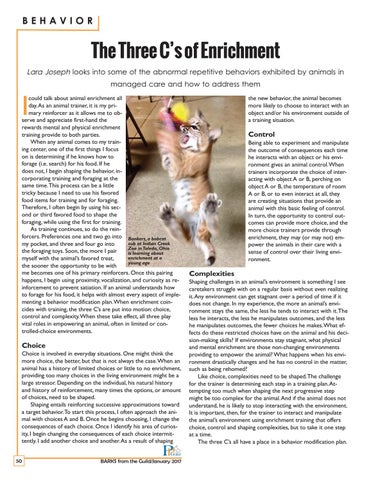BEHAVIOR
The Three C’s of Enrichment
Lara Joseph looks into some of the abnormal repetitive behaviors exhibited by animals in
I
managed care and how to address them
could talk about animal enrichment all day. As an animal trainer, it is my primary reinforcer as it allows me to observe and appreciate first-hand the rewards mental and physical enrichment training provide to both parties. When any animal comes to my training center, one of the first things I focus on is determining if he knows how to forage (i.e. search) for his food. If he does not, I begin shaping the behavior, incorporating training and foraging at the same time. This process can be a little tricky because I need to use his favored food items for training and for foraging. Therefore, I often begin by using his second or third favored food to shape the foraging, while using the first for training. As training continues, so do the reinforcers. Preferences one and two go into Bonkers, a bobcat cub at Indian Creek my pocket, and three and four go into Zoo in Toledo, Ohio the foraging toys. Soon, the more I pair is learning about enrichment at a myself with the animal’s favored treat, young age the sooner the opportunity to be with me becomes one of his primary reinforcers. Once this pairing happens, I begin using proximity, vocalization, and curiosity as reinforcement to prevent satiation. If an animal understands how to forage for his food, it helps with almost every aspect of implementing a behavior modification plan. When enrichment coincides with training, the three C’s are put into motion: choice, control and complexity. When these take effect, all three play vital roles in empowering an animal, often in limited or controlled-choice environments.
Choice
Choice is involved in everyday situations. One might think the more choice, the better, but that is not always the case. When an animal has a history of limited choices or little to no enrichment, providing too many choices in the living environment might be a large stressor. Depending on the individual, his natural history and history of reinforcement, many times the options, or amount of choices, need to be shaped. Shaping entails reinforcing successive approximations toward a target behavior. To start this process, I often approach the animal with choices A and B. Once he begins choosing, I change the consequences of each choice. Once I identify his area of curiosity, I begin changing the consequences of each choice intermittently. I add another choice and another. As a result of shaping 50
BARKS from the Guild/January 2017
the new behavior, the animal becomes more likely to choose to interact with an object and/or his environment outside of a training situation.
Control
Being able to experiment and manipulate the outcome of consequences each time he interacts with an object or his environment gives an animal control. When trainers incorporate the choice of interacting with object A or B, perching on object A or B, the temperature of room A or B, or to even interact at all, they are creating situations that provide an animal with this basic feeling of control. In turn, the opportunity to control outcomes can provide more choice, and the more choice trainers provide through enrichment, they may (or may not) empower the animals in their care with a sense of control over their living environment.
Complexities
Shaping challenges in an animal’s environment is something I see caretakers struggle with on a regular basis without even realizing it. Any environment can get stagnant over a period of time if it does not change. In my experience, the more an animal’s environment stays the same, the less he tends to interact with it. The less he interacts, the less he manipulates outcomes, and the less he manipulates outcomes, the fewer choices he makes. What effects do these restricted choices have on the animal and his decision-making skills? If environments stay stagnant, what physical and mental enrichment are those non-changing environments providing to empower the animal? What happens when his environment drastically changes and he has no control in the matter, such as being rehomed? Like choice, complexities need to be shaped. The challenge for the trainer is determining each step in a training plan. Attempting too much when shaping the next progressive step might be too complex for the animal. And if the animal does not understand, he is likely to stop interacting with the environment. It is important, then, for the trainer to interact and manipulate the animal’s environment using enrichment training that offers choice, control and shaping complexities, but to take it one step at a time. The three C’s all have a place in a behavior modification plan.
